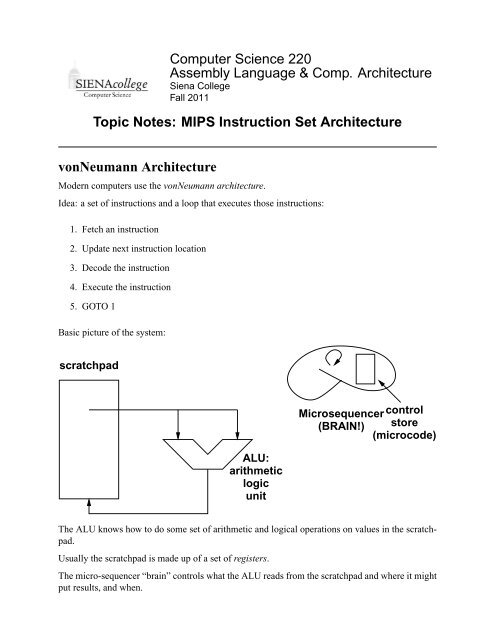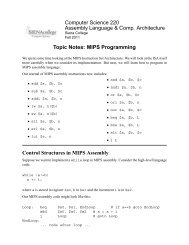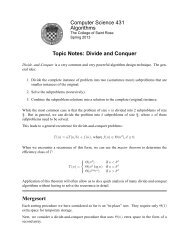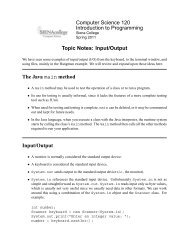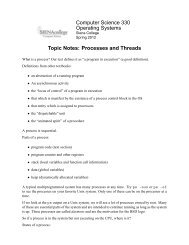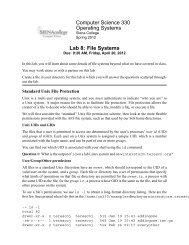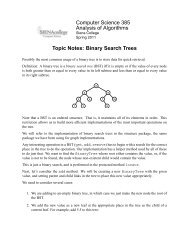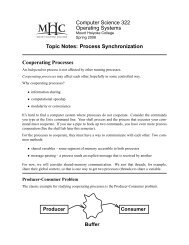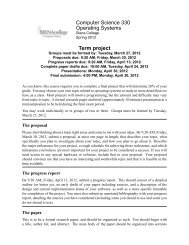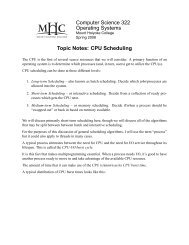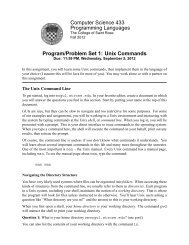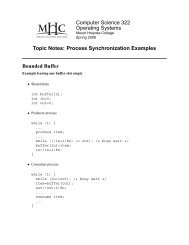Topic Notes: MIPS ISA - Courses
Topic Notes: MIPS ISA - Courses
Topic Notes: MIPS ISA - Courses
Create successful ePaper yourself
Turn your PDF publications into a flip-book with our unique Google optimized e-Paper software.
CS 220 Assembly Language & Computer Architecture Fall 2011<strong>MIPS</strong> Instruction Set ArchitectureWe will look at the <strong>MIPS</strong> instruction set architecture (<strong>ISA</strong>).Recall from our first day that the <strong>ISA</strong> is a key abstraction:• interface between hardware and low-level software• standardizes instructions (the languages of the machine), machine language bit patterns, etc.This idea has many advantages, one being that we can have different underlying hardware implementationsof the same <strong>ISA</strong>. Some may be more efficient (faster) than others, some may be slowerbut cheaper or easier to construct.On the down side, sticking to an <strong>ISA</strong> can sometimes slow innovation. A manufacturer may notwish to change the <strong>ISA</strong>, especially for a successful <strong>ISA</strong> that already has lots of software.Discussion: how important is binary compatibility?The definition of the <strong>ISA</strong> is like a contract: it lays out a set of instructions. Software can use thoseinstructions and expect that any hardware implemenation of the <strong>ISA</strong> will execute those instructionscorrectly.This is very similar to the way you can use a class someone else has written in a language like Java(think: ArrayList). You can trust that it does what it says it does and does it correctly, but itdoesn’t matter how it works internally.<strong>MIPS</strong> processors are in extensive use by NEC, Nintendo, Cisco, SGI, Sony, etc.<strong>MIPS</strong> is an example of reduced instruction set computer (RISC) architecture.RISC architectures have a fewer number of simple instructions than complex instruction set computer(CISC) architectures.Later, we will discuss the relative advantages of the RISC and CISC approaches.For now:• Good news: not many instructions or addressing modes to learn• Bad news: a single instruction performs only a very simple operation, so programming atask takes more instructions• More good news: all modern <strong>ISA</strong>s have similar types of instructions, so what we learn for<strong>MIPS</strong> will let you quickly learn more about any <strong>ISA</strong><strong>MIPS</strong> Arithmetic Instructions<strong>MIPS</strong> arithmetic instructions have three operands:3
CS 220 Assembly Language & Computer Architecture Fall 2011add a, b, cThis instruction takes the sum of scratchpad values b and c and puts the answer into scratchpadvalue a.It is equivalant to the C code:a = b + c;What if we want to code the following:a = b + c + d;We need to do it in two steps:add a, b, cadd a, a, dNote that multiple operands may refer to the same scratchpad location.The sub instruction is similar.<strong>MIPS</strong> Registers and MemoryIn <strong>MIPS</strong>, the operands must be registers. It is this collection of registers (the register file) thatforms the scratchpad.• 32 registers are provided• each register stores a 32-bit value• compilers associate program variables with registers• registers are referred to by names such as $s0 and $t1• we use the “s” registers for values that correspond to variables in our programs• we use the “t” registers for temporary values (more on this later)For example, consider this example from the text:f = (g + h) - (i + j);4
CS 220 Assembly Language & Computer Architecture Fall 2011We choose (or better yet, a compiler chooses) registers to store the values of our variables: f in$s0, g in $s1, h in $s2, i in $s3, and j in $s4.We’ll also need two temporary values, which we will store in $t0 and $t1.The <strong>MIPS</strong> code:add $t0, $s1, $s2add $t1, $s3, $s4sub $s0, $t0, $t1What if you need more variables than there are registers?Access memory!• think of memory as a large, one-dimensional array• a memory address is an index into this array of values• memory is a much larger storage space than registers, but access to that space is slower• <strong>MIPS</strong> arithmetic (and other) instructions can’t operate directly on values in memory• data must be transferred first from memory into a register, then the answer transferred backSince registers are 32-bit (4-byte) values, we often access memory in words instead of bytes.• 2 32 bytes with byte addresses from 0 to 2 32 − 1• 2 30 words with byte addresses 0, 4, 8,...2 32 − 4• words must be aligned on 4-byte boundariesSo suppose we have the following C code to translate to <strong>MIPS</strong>:A[12] = h + A[8];where A is an array of word-sized values.We have the address of the first element of A in register $s3 and h has been assigned to $s2.First, note that the values in the array A are word-sized, so each entry takes 4 bytes. We can findentries in the array:5
CS 220 Assembly Language & Computer Architecture Fall 2011A[0] $s3+0A[1] $s3+4A[2] $s3+8... ...A[8] $s3+32... ...A[12] $s3+48The notation to get the value at location $s3+4, for example, is 4($s3).So what we’d like to write:add 48($s3), $s2, 32($s3)But we can’t, since <strong>MIPS</strong> arithmetic instructions can’t operate on values in memory. We’ll have tocopy the value A[8] into a temporary register, add into a temporary register, then store the valuein A[12].The code:lw $t0, 32($s3)add $t0, $s2, $t0sw $t0, 48($s3)The new instructions are to load a word lw and store a word sw.Aside: why is it OK to overwrite the value in $t0 in the add instruction even though our originalC code doesn’t change A[8]?The address in $s3 is called a base register and the constants we add to it are called the offsets.Immediate Addressing ModeWe often need to deal with constants. So far, the only way we’d be able to add a constant to aregister is by having that constant in a register or a memory location (and how exactly would weget it there?).So there is a special format of the add instruction: add immediate, specified as addi. Its thirdoperand is a constant value used in the addition.addi $s2, $s2, 4<strong>MIPS</strong> Machine Language<strong>MIPS</strong> assembly instructions correspond to 32-bit <strong>MIPS</strong> machine instructions.For example:6
CS 220 Assembly Language & Computer Architecture Fall 2011add $t1, $s1, $s2This corresponds to the machine instruction00000010001100100100000000100000Somehow, the fact that this is an add instruction and which registers are involved is encoded inthis particular 32-bit value.We interpret the 32-bit value in this case by breaking it down into fields according to the instructionformat.The meanings of the fields:• op: the opcode – 6 bitsop rs rt rd shmat funct6 bits 5 bits 5 bits 5 bits 5 bits 6 bits0 17 18 8 0 32000000 10001 10010 01000 00000 100000• rs: the first register source operand – 5 bits (why?)• rt: the second register source operand – 5 bits• rd: the register destination operand – 5 bits• shmat: the shift amount — 5 bits (more later)• funct: the variant of the operation – 6 bitsThis is an example of an R-type (register) instruction, which is encoded in the R-format. These arethe instructions that require three registers to be specified.The 32 registers are encoded as follows:Name Register Number Usage$zero 0 constant value 0$at 1 reserved for assembler use$v0-$v1 2-3 values for results and expression evaluation$a0-$a3 4-7 procedure parameters$t0-$t7 8-15 temporary variables$s0-$s7 16-23 saved variable values$t8-$t9 24-25 more temporary variables26-27 reserved for operating system use$gp 28 global pointer$sp 29 stack pointer$fp 30 frame pointer$ra 31 return address7
CS 220 Assembly Language & Computer Architecture Fall 2011Other instructions don’t need three registers. Immediate mode instructions, for example, need 2registers and a constant value. These are I-type instructions, stored in the I-format:addi $s1, $s2, 100op rs rt address6 bits 5 bits 5 bits 16 bits8 17 18 100001000 10001 10010 0000000000110100Here, three of the fields are replaced by a single 16-bit field called address. For the addiinstruction, this stores the constant value to be added.The load and store instructions use this format as well.lw $t0, 1200($t1)This instruction’s function is to retrieve the value from memory at the address pointed to by thecontents of $t1, offset by 1200, and store the value in $t0.op rs rt address35 9 8 1200010101 01001 01000 0000010010110000The sw instruction is similar, with opcode 43.<strong>MIPS</strong> Logical InstructionsWe will look quickly at the logical shift instructions: sll and srl, which stand for shift leftlogical and shift right logical, respectively.These instructions use the shamt field in an R-format instruction:sll $t2, $s0, 4op rs rt rd shmat funct0 0 16 10 4 0Note that rs is not used.Recall that these are quick ways to multiply and divide by powers of 2.Bitwise and, or, nor follow the R-format, much like add, and the immediate versions andiand ori follow the I-format, like addi.8
CS 220 Assembly Language & Computer Architecture Fall 2011<strong>MIPS</strong> Control Flow InstructionsAny non-trivial program needs to make decisions, hence the conditional branch instructions:beq reg1, reg2, labelbne reg1, reg2, labelbeq will cause a branch to the statement labeled label if the values of reg1 and reg2 areequal, and continue to the next instruction otherwise.bne branches when not equal.These use the I-format for the machine instruction:bne $s0, $s1, Exitop rs rt address5 16 17 ExitThe address has to fit in 16 bits, so does this mean we can only branch to a 16-bit address? No- we usually use the address field as a relative offset to the program counter (PC): PC-relativeaddressing.So if the label Exit is 44 away in the positive direction from the current program counter, westore 11 in the address field.We divide by 4 since we know the bottom 2 bits are 0’s anyway (addresses are word-addressable).This means we can jump anywhere from −2 17 to 2 17 from the current PC.Note: the PC is incremented (by 4, as instructions are word-sized) early in the execution of agiven instruction. (Step 2 of Fetch, Update, Decode, Execute). Therefore, by the time we’re reallyexecuting an instruction, it contains the address of the next instruction to be executed. A branchthat is taken simply needs to modify the PC before we fetch the next instruction.There is also an unconditional jump instruction:j labelNo registers here, so we have more bits available for the address. This is a J-format instruction.If we want to jump to memory location 4848, the instruction is:op address6 bits 26 bits2 12129
CS 220 Assembly Language & Computer Architecture Fall 2011Again, the bottom 2 bits are always 0, so we divide our intended jump target by 4 when encodingthe instruction.We can also perform inequality comparisons with two more instructions:slt $t1, $s2, $s1slti $t2, $t4, 8These are set on less than instructions, and set the value of the target register to 1 if the secondoperand is less than the third, 0 otherwise.We can use these to implement all of the conditional and looping constructs we are used to inhigh-level languages.Suppose i is in $s0, j is in $s1, and h is in $s3.if (i==j) h = i + j;<strong>MIPS</strong> assembly:bne $s0, $s1, Labeladd $s3, $s0, $s1Label: ...Slightly more complex:if (i!=j) h = i + j;else h = i - j;assembles to:beq $s0, $s1, ElsePartadd $s3, $s0, $s1j OverIfElsePart:sub $s3, $s0, $s1OverIf: ...And an inequality:if (i
CS 220 Assembly Language & Computer Architecture Fall 2011assembles to:slt $t0, $s0, $s1beq $t0, $zero, ElsePartadd $s3, $s0, $s1j OverIfElsePart:sub $s3, $s0, $s1OverIf: ...Larger Constants in <strong>MIPS</strong>So far, we have seen how to get 16-bit constants to use in immediate mode instructions. But whatif we want a 32-bit constant?<strong>MIPS</strong> requires that all instructions fit in a single 32-bit word, so we can’t have an opcode and thewhole 32-bit constant at once.It takes two instructions:First, “load upper immediate”:lui $t0, 0xa532This sets $t0 to 0xa5320000. It is an I-format instruction, using the address field of thatformat to get the 16 bits for the top half of the specified register.We can then put in appropriate lower order bits:ori $t0, 0x8d7eThis will “or in” the bottom bits to have the constant specified, leaving the upper bits that we’vealready set alone. $t0 is now 0xa5328d7e.What Else is Missing?The <strong>MIPS</strong> <strong>ISA</strong> doesn’t provide instructions for operations that can easily be expressed as an existingoperation.For example, you might want to copy a value in one register to another:move $t0, $t1This is valid <strong>MIPS</strong> assembly language, but not valid <strong>MIPS</strong> machine language. This is a pseudoinstruction.As assembler would encode this as:11
CS 220 Assembly Language & Computer Architecture Fall 2011add $t0, $t1, $zeroIn this case, there’s no extra cost. It’s still just one instruction.Other pseudoinstructions may translate to more than one instruction. For example, the pseudoinstructionbgt, which branches on greater than:bgt $s1, $s2, Labelwould likely translate toslt $at, $s2, $s1bne $at, $zero, LabelNote the use of the “reserved for assembler use” register $at.Others:• li – load immediate• la – load address• sgt, sle, sge – set on ...• bge, bgt, ble, blt – conditional branchesWhen determining relative costs of different translations of high-level language into assembly,this pseudoinstruction should be considered to cost twice as much as a regular instruction or apseudoinstruction that corresponds directly to a single machine instruction.The text goes into more detail about the <strong>MIPS</strong> <strong>ISA</strong>, including the mechanisms for procedure calls,I/O, and more. We will return to some of this later.12


